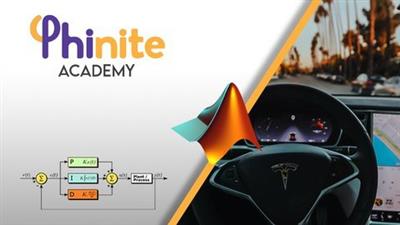Wheel Model - PID Controller in MATLAB/Simulink
- 30.06.2021
- 180

Genre: eLearning | MP4 | Video: h264, 1280x720 | Audio: AAC, 48.0 KHz
Language: English | Size: 651 MB | Duration: 1h 43m
You'll learn how to design a controller System in Matlab using System Dynamics methods!
What you'll learn
Control System
Transfer Function and State Space Representation
Control Theory
Mechatronic and System Dynamic
PID Control
Proportional Control Design
Closed-Loop Control
Reference Tracking
Wheel Model
Matlab/Simulink PID Controller Design
Description
In this course, how to create system dynamics models, which are one of the basic areas of mechatronic systems and which are actively used in mathematical modeling applications, are explained. The use of analogy models and its relationship with energy principles in an active form are given in this course.
The problem of transforming theory into practice or transferring the theory to a simulation environment, which is one of the biggest problems of engineering students, will be tried to be overcome with MATLAB applications. The SIMULINK interface has been actively preferred in the Matlab application. In this program, it is aimed to model the systems in real time / iterative and to get time responses. In addition, the input values given to the system and the effect of these values on the result are discussed.
In order to realize the system modeling, especially the equations of motion have been tried to be implemented by Transfer Function and State-Space Model. The main purpose of the system modeling applications given on the frequency base is to obtain the characteristics of linear systems and to create an interface for the development of tools to be used in control problems. In the State-Space model, it is shown how the system can be modeled even in a nonlinear state. The active use of "Matlab Function" expressions in MATLAB/SIMULINK program especially for Script Application is one of the contents of this course.
In addition, as another problem, how the system parameters that need to be transferred to real life are equated in theory and turned into design parameters is one of the active outputs of this course. It is aimed to clarify the designs in a time-dependent model, especially with the understanding of mass / spring / damper analogies and obtaining the material selection / design parameters in 3-Dimensional space.
Screenshots

Download link:
rapidgator_net:
https://rapidgator.net/file/e8d7cc7c54ba02dc9327bb4394c29182/tbcih.Wheel.Model..PID.Controller.in.MATLABSimulink.rar.html
uploadgig_com:
https://uploadgig.com/file/download/bade364402cF65dd/tbcih.Wheel.Model..PID.Controller.in.MATLABSimulink.rar
nitroflare_com:
https://nitro.download/view/6727017215EF8EB/tbcih.Wheel.Model..PID.Controller.in.MATLABSimulink.rar
https://rapidgator.net/file/e8d7cc7c54ba02dc9327bb4394c29182/tbcih.Wheel.Model..PID.Controller.in.MATLABSimulink.rar.html
uploadgig_com:
https://uploadgig.com/file/download/bade364402cF65dd/tbcih.Wheel.Model..PID.Controller.in.MATLABSimulink.rar
nitroflare_com:
https://nitro.download/view/6727017215EF8EB/tbcih.Wheel.Model..PID.Controller.in.MATLABSimulink.rar
Links are Interchangeable - No Password - Single Extraction